Galapagos Islands (Geography)
Contents
Galapagos Islands
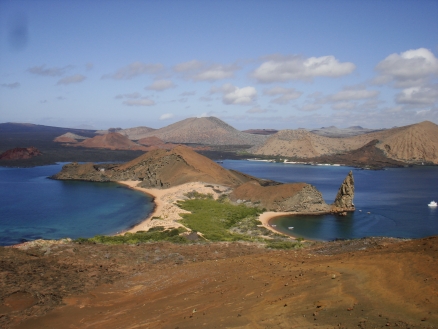
Bartolomé Island view, Galapagos Islands. Pinnacle Rock is seen at right. (By Pete from USA (Bartolome View) (http://creativecommons.org/licenses/by-sa/2.0), via Wikimedia Commons)
The Galapagos Islands include 31 individual islands, 42 islets and 26 emergent rocks thatform an archipelago located about 600 miles west of South American in the Pacific Ocean. The islands, which are part of Ecuador, have been designated as a National Park andas a UNESCO World Heritage Site. The Galapagos Islands are known for being home to many species of plants and animals that are not found anywhere else on the planet. The Galapagos Islands were named from the old Spanish word "galapago" (saddle) because of the shape of the shells of the islands' giant tortoises.
History and Overview
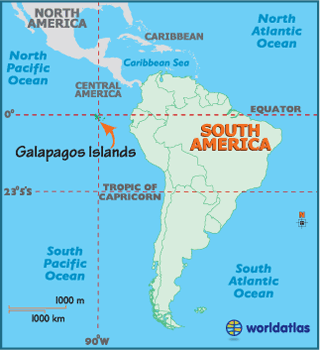 Location of Galapagos Islands. worldatlas.com
Location of Galapagos Islands. worldatlas.com
The Galapagos Islandsareoceanic islandsthat havenever been connected to any landmass. Instead these islands were produced by volcanic activity. Isabella, was formed by six volcanoes, but most islands were formed by the activity of only a singlevolcano. The islands are quite young geologically, ranging in age from five million to only hundreds of thousands of years old.
The Galapagos Islands were discovered in the 1500s by Fray Tomas de Berlanga while he wassailing from Panama to Peru. In 1835, Charles Darwin visited the Galapagos Islands as part of his five year journey on the Beagle. His observations of Galapagoswildlife helped shape his ideas on evolution and natural selection. Today, the Galapagos Islands are a very popular tourist destination as well as host to a scientific research center.
Geography and Climate
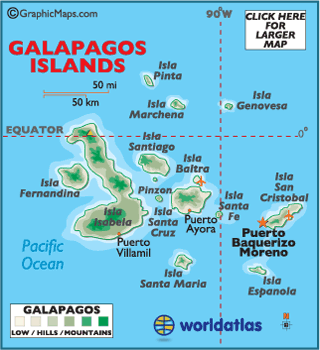 Galapagos Islands. worldatlas.com
Galapagos Islands. worldatlas.com
The Galapagos Islands are made up of a total land area of 4588 square miles and are divided into 3 geological zones. The South East zoneincludes Isabela, Fernandina, and Floreana Islands, theNorthern zone containsDarwin, Wolf, Marchena, Pinta, and Genovesa Islans, while the third zone is composed of the central islands.
The Galapagos lie on the equator butexperience a subtropical climate which is different from the tropical climate usually found at the equator. The reason for the Galpagos’s climate is the intersecting ocean currents which lead to two different seasons. The Garúa or dry season which occurs from May – December as a result of the cool Humboldt Current ischaracterized by drizzling rain, and cooler temperatures. The hot or wet season which occurs from December to May is accompanied by hotter temperatures and heavy rain fall caused by the warm Panama Current.
Wildlife and Plants
The volcanic islands lacked all life when they initially rose above sea level, so the ancestors of all species currently found on the island had to colonize from the outside, carriedeither by air, by sea, or, more recently, by humans. Ocean currents aided the colonization of swimmers such as sea lions, sea turtles, and penguins), while other animals such as small mammals and reptiles would have been carried from the mainland on rafts of vegetation. Because amphibian skin makes it difficult for amphibians to survive rafting, there are no native amphibians in the Galapagos Islands. Sea birds were able to easily fly to the islands, but the colonization of weak fliers was probably aided by the wind.
The tiny, light-weight spores of ferns and mosses were blown by the wind.Plant seedswere carried either by ocean current (e.g. mangroves),the wind, on on the feathers, feet, and guts of birds. Large-seeded flowering plants are rare on the Galapagos Islands because of poor dispersal by the wind, but wind-dispersed members of the Asteraceae (e.g., dandelions) are common on the islands. The diversity of flowering plants might also be low because insect pollinators have yet to colonize the islands.
Endemism is high on the the Galapagos Islands; over 180 species of plants, 20 species of reptiles, 5 species of seabirds, 24 land birds and 6 mammals are only found there. Many endemic species in the Galapagos Islands have multiple subspecies because populations are reproductively isolated on different islands.
Humans have accidentally or purposefully introduced a number of species to the Galapagos Islands. Over 30 species of vertebrates, including goats, rats, cats, pigs, dogs, chickens and ducks, 750 species of plants, and 500 species of insects have been introduced to the islands. The National Park Service and the Charles Darwin Research Foundation have been working together to reduce the effects of harmful introduced species.In spite of the harmful influence of introduced species, about 95% of the islands' native species remain today.
Terrestrial species
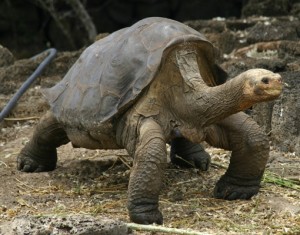 Lonesome George, the last remaining Galapagos giant tortoise from the subspecies form Pinta Island. photo by Tim Saxe. Galapagos Conservency
Lonesome George, the last remaining Galapagos giant tortoise from the subspecies form Pinta Island. photo by Tim Saxe. Galapagos Conservency
Galapagos tortoises
Ancestors of the giant tortoises of the Galapagos Islands were thought to have arrived 2 - 3 million years ago. The Galapagos giant tortoise (Chelonoidis nigra) can grow up to 1.8 meters long and weight up to 400 kg. These tortoises are herbivores that feed on cactus, fruit, and grasses. There are currently ten subspecies of giant tortoises in the wild. Lonesome George, the last remaining individual of a subspecies found on Pinta Island, died in 2012.
Iguanas
The Galapagos Islands are home to three species of land iguana and one species of marine iguana. The land iguanas may reach more than one meter in length and can weight up to 30 pounds. They are herbivores that feed on leaves, cactus pads, and fruits and they receive much of the water they require from the succulent plants in their diet.
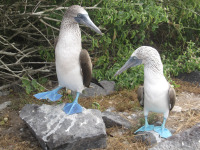 Blue-footed boobies. Photo Galapagos Conservation Trust Frigatebirds and Boobies
Blue-footed boobies. Photo Galapagos Conservation Trust Frigatebirds and Boobies
Three species of boobies (blue-footed boobie, Nazca boobie, and red-footed boobie) and two species of frigatebirds (magnificent frigatebird and great frigatebird) are among the many species of sea birds that live on the Galapagos Islands. Boobies and frigatebirds can be observed nesting in large colonies. The lack of mammalian predators has caused these shorebirds to lose their fear, so it is possible to approach these birds quite closely.
Marine species
Seals and sea lions
The Galapagos sea lion (Zalophus californicus woolebacki) is likely to be the first animal species that welcomes visitors to the islands. They are the largest animals found in the Galapagos with males weighing up over 500 pounds. Sea lions are carnivores that eat fish that they catch on extended feeding trips in the sea. Galapagos fur seals (Artocephalus glapagoensis) are smaller. They are nocturnal carnivores that feed on fish and squid.
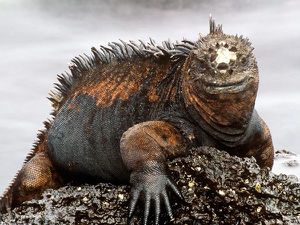 Marine Iguana. photo by Rob Stewart/Animals Animals. National Geographic
Marine Iguana. photo by Rob Stewart/Animals Animals. National Geographic
Marine iquanas
The marine iguanas (Amblyrhynchus cristatus) are the only marine lizards in the world. They live on land but primarily feed on algae in the sea. They can commonly be observed basking in the sun on rocks near the sea.
Galapagos penguins
The endemic Galapagos penguin (Spheniscus mendiculus), the only species of penguin found north of the equator, are located mainly in the western islands of Isabella and Fernandina. They are the smallest South American penguin growing less than 50 cm tall. With a remaining population of less than 2000individuals, they are considered to be an endangered species.
The Galapagos Today
The number of people living on the islands has increased rapidly since the 1970s. Approximately 25,000 people inhabit five of the thirty-one islands. In 1968, Ecuador establishedthe Galapagos Islands as aNational Park. Since1969 tourismhave been a huge economic boost to the islands. The islands hosted over 180,000 visitors in 2012 with tourism drivingabout half of the Galapagos economy.
References and Further Reading
- Galapagos A Natural History Guide by Pierre Constant
- Galapagos Islands. UNESCO.[[1]]
- Galapagos Islands xeric scrub. Encyclopedia ofEarth. [[2]]
- Galapagos Conservency.http://www.galapagos.org/about_galapagos/history/
- Galapagos Penguins.https://worldwildlife.org/species/galapagos-penguin
- Galapagos Giant Tortoise. Encyclopedia of Life.http://eol.org/pages/794300/overview
- Galapagos Tourism. Sangay Touring.http://www.sangay.com/2011_GPS_STATS.html
- The Three Boobies of the Galapagos Islands. , http://www.galapagos.org/wp-content/uploads/2012/04/BoobyFactSheet.pdf
- Galapagos Conservation Trust. http://www.savegalapagos.org/bluefootedboobyday/blue-footed-booby-facts.shtml
- Charles Darwin Foundation.http://www.darwinfoundation.org/
- Galapagos Islands.http://www.aboutgalapagos.com/conservation/species-introduced-to-galapagos/
This article was written by students at Texas Tech University participating in the Encyclopedia of Earth's Student Science Communication Project. The project encourages students in undergraduate and graduate programs to write about timely scientific issues under close faculty guidance. All articles have been reviewed by internal EoE editors and by independent experts on each topic.